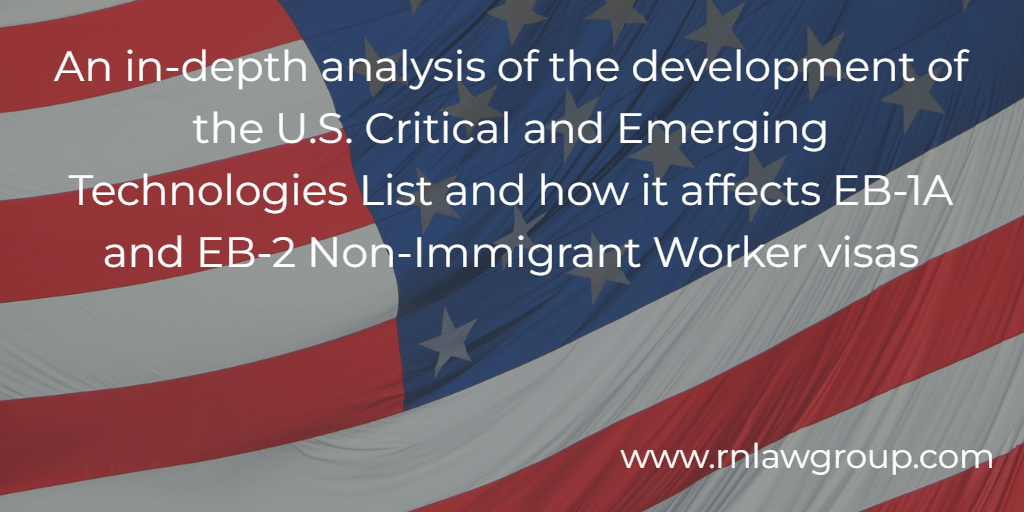
An in-depth analysis of the development of the U.S. Critical and Emerging Technologies List and how it affects EB-1A and EB-2 Non-Immigrant Worker visas
An new edition of the Critical and Emerging Technologies (CET) list was released by the U.S. White House in February 2022. This document identifies technologies that are considered critical to the security and economic well-being of the country, acting as a strategic roadmap. The CET list update reflects the changing nature of innovation and geopolitical issues by highlighting technological advancements and changes in priority. Here, we offer a thorough analysis of this new list, covering the categories, particular technologies, wider policy and strategy ramifications, and effects on EB-1A and EB-2 NIW visas.
Overview of Emerging and Critical Technologies
The preservation of societal well-being, economic competitiveness, and national security depend heavily on Critical and Emerging Technologies (CET). These technologies cover a broad spectrum of industries, including biotechnology, sophisticated materials, artificial intelligence, and advanced computing. The CET list is updated on a regular basis to make sure it stays current in the face of swift technology change and evolving world conditions.
Principal Areas of the CET List
The latest CET list divides technology into a number of major categories, each of which stands for an important field for further development. These areas consist of:
- Advanced Computing
- Artificial Intelligence (AI)
- Biotechnology
- Advanced Materials
- Energy Technologies
- Quantum Information Science
- Robotics
- Space Technologies
- Communications and Networking Technologies
Comprehensive Analysis of Every Category
- Advanced Computing
HPC, or high-performance computing: For scientific research, weather forecasting, and simulations that support economic and national security endeavors, high performance computing (HPC) systems are indispensable. Increasing processing power and efficiency is the main goal.
The goal of neuromorphic computing is to create systems that can carry out complicated tasks while using the least amount of energy possible. It is inspired by the structure of the human brain.
For Internet of Things and real-time applications, edge computing reduces latency and bandwidth utilization by processing data closer to the point of generation.
- AI, or artificial intelligence
Machine Learning (ML): ML techniques allow systems to learn from and adapt to data, resulting in advances in a number of industries, such as banking, healthcare, and military. Natural Language Processing (NLP): By allowing computers to comprehend and react to human language, NLP promotes human-computer interaction.
Autonomous Systems: These AI-powered autonomous systems, which include drones and self-driving cars, have the potential to improve logistics, transportation, and defense.
- Biotechnology
Synthetic biology is a science that blends engineering and biology to create new biological systems and parts that can be used in environmental management, agriculture, and medicine.
Genetics: Progress in genomics has made it possible to comprehend and modify genetic material, which has opened the door to biotechnological and customized medicine.
Bioinformatics: Bioinformatics is the integration of biology, computer science, and information technology. It is essential for the management, analysis, and support of biological research and development of data.
- Advanced Materials
Nanomaterials: Materials with special qualities that are engineered at the nanoscale have led to advances in electronics, energy storage, and medicine.
Metamaterials: With characteristics not found in nature, these materials provide advances in electromagnetic, acoustic, and optical applications.
Smart Materials: Adapting to their surroundings, smart materials find use in a number of industries, such as robotics, aerospace, and medical.
- Energy Technology
Advanced Nuclear Energy: Safer and more effective energy production is promised by advancements in nuclear reactor design, such as small modular reactors (SMRs) and fusion energy.
Technologies for renewable energy include solar, wind, and bioenergy. Their goals are to lessen reliance on fossil fuels and to slow down the effects of climate change. Energy Storage: To stabilize renewable energy sources and guarantee a steady supply of electricity, technological advancements in batteries and other energy storage systems are essential.
- Quantum Information Science
Quantum computing: Compared to classical computers, quantum computers may execute difficult computations tenfold quicker by utilizing the ideas of quantum physics.
Quantum sensing: With its applications in navigation, medical imaging, and environmental monitoring, quantum sensing makes use of quantum features to obtain unparalleled sensitivity in measurement.
Quantum Communication: This technology is essential for data protection and national security since it ensures secure communication using quantum encryption techniques.
- Automation
Collaborative Robots (Cobots): Designed to operate alongside humans, cobots improve safety and productivity across a range of industries, such as healthcare and manufacturing. Swarm Robotics: Drawing inspiration from natural systems, swarm robotics uses a group of robots collaborating to accomplish intricate tasks. It finds applications in defense, agriculture, and search and rescue.
Medical robotics: Through automation and robotic support, advances in this sector enhance surgical accuracy, patient care, and rehabilitation.
- Space Technologies
Satellite Technology: Developments in satellite architecture, launch, and operation improve the world’s capacity for navigation, earth observation, and communications.
Space Exploration: The creation of space habitats and manned expeditions to the Moon and Mars are made possible by technological developments.
Space Situational Awareness: Maintaining the viability of space operations and safeguarding space assets requires the tracking and management of space trash and other objects in orbit.
- Networking and Communications Technologies
5G and Beyond: To enable the Internet of Things, driverless cars, and advanced telecommunications, 5G network rollout and research into next-generation communication technologies are crucial.
Cybersecurity: It is crucial to safeguard data and digital infrastructure against cyberattacks, which calls for constant improvements in threat detection, encryption, and response technologies.
Advanced Networking Technologies: The flexibility, effectiveness, and security of communication networks are improved by networking innovations like network function virtualization (NFV) and software-defined networking (SDN).
Consequences and Strategic Points to Remember
The updated 2022 CET list highlights various strategic factors that the US should take into account:
- National Security: To preserve the ability to defend the country, technical dominance is essential. Technologies that improve military resiliency and effectiveness are given priority on the CET list.
- Economic Competitiveness: Being a leader in important and cutting-edge technology promotes economic expansion, brings in well-paying jobs, and guarantees that the United States stays at the front of worldwide innovation.
- International Cooperation: To solve global issues like pandemics, climate change, and cybersecurity threats, international cooperation is crucial, even as we preserve our technological leadership.
- Ethical and Responsible Development: It is important to carefully assess the ethical implications of developing technologies, such as biotechnology and artificial intelligence, to make sure they minimize hazards and advance society.
- Education and Workforce Development: It’s imperative to develop a workforce with the skills necessary to advance and make use of these technologies. To fulfill future demands, funding for STEM education and training programs is required.
Effect on NIW Visas (EB-1A and EB-2
The Employment-Based First Preference for Extraordinary Ability (EB-1A) and Employment-Based Second Preference for National Interest Waiver (EB-2 NIW) visa categories are greatly impacted by the new CET list. The goal of both visa categories is to draw in highly qualified workers who can progress technology and the American economy.
Eligibility and Preference for EB-1A Visas: Those with exceptional talent in the sciences, arts, education, business, or athletics are eligible for the EB-1A visa. The U.S. government’s interest in luring outstanding talent in these vital fields is demonstrated by the inclusion of particular technologies on the CET list. Those who have made significant contributions to and breakthroughs in CET fields like biotechnology, AI, and quantum computing are more likely to be eligible for this type of visa.
Simplified Approval: For EB-1A candidates, proving proficiency in a technology on the CET list can expedite the approval procedure. They provide a strong argument for their exceptional talent and potential effect by contributing to these high-priority areas in line with national interests.
NIW Visas (EB-2)
National Interest Waiver: If applicants can show their job is in the best interests of the country, they may be able to avoid the labor certification process and apply for an EB-2 NIW visa. For the purpose of determining which technologies are essential to both economic competitiveness and national security, the CET list offers a clear framework. Candidates in these industries will find it easier to claim that their contributions are of great national significance.
Priority for Researchers and Innovators: Applicants for the EB-2 NIW visa who are experts in CET fields such advanced materials, cybersecurity, and renewable energy will have an advantage. Their efforts improve their eligibility for a national interest waiver by directly advancing the strategic objectives included in the CET list.
In summary
The revised Critical and Emerging Technologies list highlights technical advancements critical to national security, economic success, and societal well-being, acting as a strategic guide for the United States. Continuous evaluation and priority adjustment are required as technologies advance in order to take advantage of new possibilities and problems. In addition to outlining current technical goals, the CET list paves the way for upcoming technologies that will direct the country’s course in an increasingly complicated and challenging global landscape.
Furthermore, the CET list has a big influence on immigration laws, especially for highly qualified people applying for EB-1A and EB-2 NIW visas. The United States seeks to attract and retain top talent in vital and developing industries by coordinating visa preferences with national technology priorities. This approach ensures the country’s sustained leadership in global innovation and economic growth.
By: Karim Jivani
Karim Jivani is an Associate Attorney at Reddy Neumann Brown PC who focuses on employment-based non-immigrant visas. Karim’s practice covers all phases of the EB-1A and EB-2 NIW visa process including filing petitions, responding to Requests for Evidence (RFE), and drafting motions and appeals. Karim has also worked on all aspects of H-1B, L-1, I-140, and VAWA petitions.

